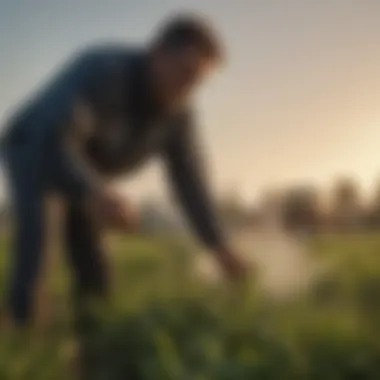Burn Down Weed Killers: Effectiveness and Impact


Intro
In the world of agriculture and landscaping, burn down weed killers are often at the forefront of debate. Farmers and gardeners alike wrestle with the challenge of controlling unwelcome vegetation. These herbicides promise efficacy, but they come with a myriad of considerations regarding safety and environmental impact. In this article, we will grapple with these aspects, aiming to provide an insightful look into how these products work, their historical context, innovations in the field, practical applications, and ways to mitigate their ecological effects.
Topic Overview
Definition and Importance
Burn down weed killers are herbicides designed to eliminate unwanted plants by targeting their green parts. Unlike residual herbicides, which stop weeds from sprouting, burn down killers focus on killing existing vegetation. This method holds significant importance for farmers and horticulturists who require quick results to maintain crop health and yield. They play a crucial role in managing weed populations, which, if left unchecked, can compete with crops for nutrients and water.
Brief History and Evolution
The evolution of burn down weed killers can be traced back to early agricultural practices. Traditional methods relied on manual removal and mechanical tools. However, as agricultural demands grew, so did the need for efficient, effective solutions. In the mid-20th century, synthetic herbicides emerged, providing farmers with powerful tools to combat weeds. Initially, substances like glyphosate became popular due to their broad-spectrum activity. Yet, as concerns over safety and environmental impact grew, the market saw a diversification of formulations, including more targeted and eco-friendlier options.
Key Techniques and Innovations
Sustainable Farming Practices
In recent years, sustainable agriculture has gained traction, prompting a shift in how burn down weed killers are utilized. Integrating these herbicides with cultural practices—like cover cropping or crop rotation—can help minimize reliance on chemicals. Farmers are encouraged to use precision application techniques, ensuring that the products target only the desired areas, reducing leaching into non-target species.
Advanced Agronomic Technologies
Innovations in agronomy have transformed the way weed management is approached. Technologies such as drone spraying systems and soil-sensing equipment enable farmers to apply herbicides with pinpoint accuracy. This not only increases the efficacy of burn down weed killers but also lessens the potential for environmental harm. Moreover, research is ongoing into biopesticides, which harness natural systems to provide alternative solutions to chemical herbicides.
Practical Applications
Step-by-Step Guides
To maximize the potency of burn down weed killers while minimizing their negative effects, the following steps can be beneficial:
- Identify target weeds: Understanding the type and growth stage of the weeds is crucial for choosing the right product and timing.
- Select the appropriate product: Choose formulations that are effective against the identified weeds, taking care to read labels for instructions.
- Timing of application: Apply herbicides during the weed's active growth phase, preferably on a calm day to prevent drift.
- Always wear the correct PPE: Proper safety gear, such as gloves and goggles, should be worn to protect oneself from chemical exposure.
Case Studies or Real-World Examples
Recent case studies illustrate the responsible use of burn down weed killers. For instance, a California vineyard adopted integrated pest management strategies, combining cover crops with selective herbicides. This approach not only reduced their weed pressure but also improved soil health and reduced overall chemical usage. Similarly, farms in Canada have started using smartphone apps that utilize data analytics to forecast weed outbreaks and apply herbicides at the most effective times, thus decreasing both costs and environmental risks.
"Effective weed management isn't about eliminating all herbicides; it's about using them wisely and sustainably."
Foreword to Burn Down Weed Killers
Understanding burn down weed killers is akin to unraveling a complex puzzle. These chemical agents play a pivotal role in modern agriculture and horticulture, serving as vital tools for managing unwanted vegetation. The burning question, however, is: why should we pay more than just casual attention to these substances?
Burn down weed killers are designed not just to control weeds but to obliterate them entirely, making way for desired crops and plants. They accomplish this through specific mechanisms that directly target the physiology of the weeds themselves. The implications of using these products extend beyond mere aesthetics – they affect productivity, yield, and ultimately the economic health of farming practices.
In this article, we will explore several aspects of burn down weed killers. We will dissect their chemical formulations, mechanisms of action, and ways to apply them effectively while also weighing their effectiveness against various factors. Importantly, we will not shy away from discussing the environmental impact and health concerns associated with these chemicals, an aspect that any conscientious farmers or horticulturists cannot afford to overlook.
Defining Burn Down Weed Killers
Burn down weed killers is a term that encompasses a wide range of herbicides whose primary purpose is to kill weeds before a harvest or planting cycle. They work by disrupting the plant's metabolic processes, leading to an inevitable demise. It’s crucial to note that these products are not selective. Unlike some herbicides that target specific species, burn down weed killers are designed to impact all green plant tissue indiscriminately. This point is essential for farmers who may have a misunderstanding about the targeted use of these agents.
When we refer to "burn down," we're referring to the immediate destruction of a weed's foliage, primarily targeting the leaves and stems while often not affecting the root systems in a single application. Consequently, they’re often used as a pre-planting or pre-emergent treatment, serving as a final strategy to assure that unwanted plants don't compete for nutrients or hinder the growth of desired crops.
The Importance in Agriculture and Horticulture
The relevance of burn down weed killers in agriculture and horticulture cannot be overstated. Farmers face enormous pressure to maximize crop yields while minimizing costs. In many scenarios, applying a burn down weed killer is an economical solution for large-scale agricultural fields that would be otherwise overwhelmed by invasive weeds.
In horticulture, professionals rely on these agents to maintain aesthetics and the ecological balance within gardens, parks, and landscaped areas. Weeds can obscure the beauty of carefully curated settings and outcompete ornamental plants. In this light, burn down weed killers serve not only as tools for health but also as instruments of design and visual appeal.
However, farmers and horticulturists must also consider the delicate balance that must be maintained within the ecosystem. While these chemicals provide immediate control over unwanted plants, understanding their long-term effects on soil health, biodiversity, and surrounding wildlife is equally important. Hence, the application of burn down weed killers should be a well-informed and strategic choice – one that considers all facets of agricultural and horticultural practices.
Chemical Composition of Burn Down Weed Killers
Understanding the chemical composition of burn down weed killers is far more than a mere academic exercise; it plays a fundamental role in evaluating their effectiveness and safety for agricultural practices. The chemistry behind these products influences everything from their potency against unwanted vegetation to their potential impact on surrounding ecosystems. The right formulation can mean the difference between a thriving farmland or a decimated habitat. Thus, a critical examination of the active ingredients and a comparison of the various formulations available can lead to informed choices, allowing for sustainable agricultural practices that do not compromise ecological health.
Active Ingredients and Their Roles
At the heart of every burn down weed killer is a set of active ingredients designed to disrupt the normal biological processes of plants. Commonly, these include glyphosate, diquat, and paraquat. Each ingredient comes with its own specific action, targeting different aspects of plant growth. For example, glyphosate works by interfering with amino acid synthesis, effectively starving the plant of the vital nutrients it requires to survive. On the other hand, diquat acts swiftly, causing cell death by targeting the plant's photosynthesis process.
It’s crucial to recognize that the effectiveness of a weed killer is intricately tied to the concentrations of these active ingredients. Higher concentrations often yield quicker results but can increase the risk of environmental damage. An understanding of these nuances enables users to select the appropriate formulation based on their needs and the specific types of weeds they are facing, while mitigating potential backlash from non-target species.
Comparative Analysis of Common Formulations
In an ever-growing market, burn down weed killers come in many varieties. Each formulation has distinct characteristics, advantages, and considerations that deserve attention.
Glyphosate-Based Products
Glyphosate-based products have garnered attention for their effectiveness across a wide range of weed species. Their primary characteristic lies in their systemic action, meaning they are absorbed through the leaves and translocated throughout the plant, leading to its death. This comprehensive action is one reason for its widespread use in agricultural settings.


However, despite their popularity, glyphosate products are not without controversy. The unique feature of glyphosate is its potential persistence in the soil, raising concern over its long-term ecological impact. Critics often point to studies suggesting possible links between glyphosate exposure and health risks, making it crucial for users to weigh these factors against the herbicide's effectiveness.
Non-Selective Herbicides
Non-selective herbicides are another breed entirely. These killers don’t discriminate between weeds and desirable plants, which means they can effectively clear a whole area. This might be beneficial for total site preparation, but comes with significant risks. Their key characteristic is their broad-spectrum action, causing immediate kills. However, in unintended hands, they can lead to a quick disaster in gardens or orchards they were never meant to treat. Careful application and consideration of surrounding flora are essential with these products.
Organic Alternatives
For those leaning towards environmentally-friendly practices, organic alternatives have emerged as viable options. These typically involve natural compounds like acetic acid or essential oils from plants that manage to inhibit weed growth. The standout feature here is that organic products often tend to break down more quickly in the environment, thereby reducing the risk of long-term contamination.
While these alternatives come with advantages such as being less harmful to beneficial organisms, they often demand more frequent applications to maintain effectiveness against robust weed species. Additionally, their efficacy can vary significantly based on environmental conditions, posing challenges for large-scale agricultural use.
In summary, understanding the chemical composition and comparing various formulations of burn down weed killers provides a solid foundation for making informed usage decisions. By examining the active ingredients and their roles, alongside the common products on the market, users can navigate the complexities of weed management more effectively.
Mechanism of Action
Understanding the mechanism of action for burn down weed killers is crucial for a variety of reasons. First, it sheds light on how these products operate within the ecosystem of agriculture and horticulture. Knowing how these herbicides affect plants allows farmers and enthusiasts to tailor their applications for optimal effectiveness while being mindful of potential environmental impacts. Furthermore, comprehending this mechanism provides insight into the necessary precautions and best practices surrounding their use, ensuring a responsible approach to weed management.
Targeting Photosynthesis and Growth Processes
Burn down weed killers primarily function by interfering with the photosynthesis process. Photosynthesis is the lifeline of plants; it’s how they convert sunlight, carbon dioxide, and water into energy. These herbicides disrupt that very process, effectively starving the target plants. For instance, glyphosate, a widely known burn down weed killer, targets a specific metabolic pathway, leading to the breakdown of necessary amino acids in plants. This pathway is not present in humans or animals, making it relatively specific in its action.
The implications of this targeting are twofold. On one hand, effectively applying these weed killers can lead to rapid deterioration of unwanted plant species. On the other hand, it necessitates careful attention to application timing and environmental conditions, as these factors play a significant role in the effectiveness of the herbicide.
- Environmental Conditions: Temperature and humidity can significantly influence how a weed killer performs. High temperatures might enhance quick absorption, while excessive rain can wash away the chemical before it has an effect.
- Plant Type: Different species react uniquely to the same herbicide. A targeted approach based on species can reduce collateral damage to desirable plants.
Adopting a methodical approach in using these herbicides can make a considerable difference in both effectiveness and ecological stewardship.
Effectiveness and Duration
The effectiveness of burn down weed killers is not just about how quickly they act, but also how long they stay active in the environment. This aspect brings into play the concept of "persistence of chemical action," which relates to how long the herbicide continues to suppress unwanted growth after application.
Several factors contribute to this effectiveness:
- Soil Type: The composition of the soil can influence how quickly or slowly herbicides break down. Sandy soils may allow quicker degradation than clay-rich soils, which tend to retain chemicals longer.
- Microbial Activity: In soils rich in microbial life, herbicides may decompose more rapidly, reducing their effectiveness and longevity.
- Application Rate: Proper dosage is vital. Too little may result in insufficient control, while too much can lead to undesirable consequences, including the potential harm to the surrounding fauna.
It’s essential to note that with increased efficacy comes the need for a more detailed understanding of usage instructions and the respective environmental rules tied to specific products. Awareness of the potential for chemical runoff, degradation pathways, and accumulation in soil can help practitioners make informed choices that balance efficacy with sustainability.
"A well-informed application of herbicides can lead to improved yields and reduced weed pressure, but knowledge is key to ensuring safety for the environment and human health."
Ultimately, understanding these facets not only enhances the adoption of burn down weed killers but also fosters an industry-wide commitment to responsible and informed agricultural practices.
Application Methods
The application methods employed in utilizing burn down weed killers are critical to their efficacy and overall impact in various agricultural and horticultural settings. The timing and technique chosen can greatly influence the success of weed management efforts. Selecting the appropriate strategies ensures maximum absorption by target plants and minimizes potential harm to surrounding flora and fauna. The precision in application not only affects weed control but also mitigates any adverse environmental repercussions that may arise from misuse.
Selecting the Right Time and Conditions
Timing and environmental conditions play an essential role in the application of burn down weed killers. For instance, applying these products during peak growth periods for the target weeds generally results in better control. Additionally, considering weather factors like temperature and humidity can significantly impact the absorption rate and efficacy of the herbicides. Applying the product in conditions that are too windy can lead to drift, which might affect non-target species and potentially harm beneficial insects or plants nearby.
Moreover, waiting until after rainfall can enhance soil moisture, facilitating the uptake of the active ingredients by the weeds. Thus, understanding local weather patterns and the growth stages of the targeted weeds can guide effective timing decisions.
Equipment for Application
Selecting the right equipment is just as important as timing. Proper tools ensure effective and efficient distribution of burn down weed killers, minimizing waste and ensuring optimal coverage. Here are some considerations regarding two primary categories of equipment: sprayers and safety gear.
Sprayers and Nozzles
Sprayers, particularly those equipped with adjustable nozzles, are essential for achieving uniform coverage when applying burn down weed killers. The choice of nozzle can significantly impact the size and pattern of the spray, which is crucial for even distribution. For instance, flat fan nozzles are popular for their ability to create a wide spray pattern that covers larger areas quickly. However, care must be taken, as they can produce small droplets that are prone to drift.
Conversely, larger droplet nozzles may reduce drift risk but could compromise coverage in dense vegetation. Thus, the key characteristic of sprayers is versatility, allowing the user to adapt nozzle types and pressures based on specific conditions.
- Advantages: Sprayers can enhance efficiency, covering vast areas in a shorter time.
- Disadvantages: They require careful handling and calibration to avoid overspray.
Safety Gear
Safety gear is an indispensable component when handling burn down weed killers, protecting individuals from potential exposure to harmful chemicals. Essential items include gloves, goggles, respirators, and long-sleeved clothing. A critical aspect of safety gear is its ability to offer barriers against skin contact and inhalation of chemical particulates, which is central to minimizing healthrisk associated with these products.
Donned properly, these protective items act as a safeguard, enabling individuals to perform their tasks with less anxiety about harmful exposure. While the initial cost of safety gear can seem steep, the long-term health benefits and peace of mind it provides are well worth the investment.
- Advantages: Ensures operator safety and reduces health risks associated with exposure.
- Disadvantages: Some users may find safety gear cumbersome or uncomfortable, potentially leading to improper use.
Proper application methods can make or break the effectiveness of burn down weed killers, influencing not only weed management outcomes but also environmental safety.
In summary, successful weed management through burn down herbicides hinges on careful planning of application methods, including timing, equipment, and safety precautions. By paying close attention to these elements, agricultural professionals can achieve better control over weed populations while minimizing harmful impacts on the environment.
Effectiveness of Burn Down Weed Killers
Understanding the effectiveness of burn down weed killers is fundamental for both growers and gardeners alike. Their role is not just a quick fix; it lays the foundation for healthier plants and better yields. Effectiveness encompasses several key elements – from the type of weeds targeted to the conditions under which these herbicides perform best.


Weed Species Control
Burn down weed killers excel in tackling a wide range of weed species, effectively nullifying competition for nutrients and sunlight. They are particularly potent against annual weeds like crabgrass and dandelions, but also show effectiveness against perennial types like thistles. This capability is crucial because uncontrolled weeds can take over, crowding out desired crops and reducing overall productivity.
The selection of an appropriate weed killer should consider the specific species prevalent in the area. For example, products containing glyphosate can be particularly efficient against glyphosate-resistant weeds when applied at the right growth stage. On the flip side, some weeds have evolved resistance against certain herbicides, necessitating the rotation of different active ingredients to maintain effectiveness.
Influencing Factors on Efficacy
Various factors play a significant role in determining the efficacy of burn down weed killers.
Soil Type
Soil type is often overlooked but is a key player in how effective these herbicides can be. For instance, sandy soils drain quickly and might lead to rapid leaching of the active ingredients, reducing the herbicide's effectiveness. Conversely, clay soils tend to hold moisture and thus can retain chemicals longer, allowing for better absorption by target weeds.
Each soil type carries its unique characteristics:
- Sandy Soils: Fast drainage, quicker leaching, less retention of herbicides.
- Clay Soils: Slower drainage, better chemical retention, more extended activity period of herbicides.
Hence, understanding the soil texture and composition helps in picking the right product and application strategy. Individuals working with heavy clay soils might find that increasing the herbicide’s concentration or adjusting the application method offers more success.
Weather Conditions
Weather conditions directly impact the performance and safety of burn down weed killers. Temperature, humidity, and precipitation needs to be considered before applying any herbicide. High temperatures can cause rapid evaporation, while rain shortly after application can wash away the chemical, rendering it ineffective. Ideally, the forecast should show dry weather for a couple of days post-application to ensure maximum absorption.
Key weather factors include:
- Temperature: Optimal ranges for effectiveness vary by product; extreme temperatures can destabilize the herbicide.
- Humidity: Influences evaporation rates, affecting how well the product sticks to the leaf surfaces.
- Rainfall: A critical enemy; timely rainfall can diminish the herbicide's potency, thus timing is everything.
"Understanding the nuances of soil types and weather conditions can be the make-or-break factor in weed control efficiency."
In summary, effective use of burn down weed killers hinges on a meticulous assessment of both weed species and surrounding conditions. It's not simply about spraying; rather, it's a calculated process that involves timing, understanding of the environment, and knowledge of your soil. For those deeply involved in agriculture or gardening, these insights pave the way for better crop management and holistic soil health.
Environmental and Health Implications
In today's rapidly changing agricultural landscape, the use of burn down weed killers poses significant environmental and health implications that demand careful consideration. Understanding these factors is paramount, not only for those directly involved in agriculture but also for policymakers and consumers who seek healthier ecosystems. The awareness of chemical impacts on biodiversity, soil health, and human safety plays a crucial role in sustainable farming practices.
The environmental aspects highlight the potential challenges these chemicals introduce to ecosystems. For instance, runoff from treated areas can affect aquatic habitats, harming fish and other organisms. Therefore, proper usage guidelines must be established to minimize such risks and ensure a balance between effective weed management and ecological preservation. Similarly, human health implications cannot be overlooked, particularly concerning long-term exposure to herbicides.
"The implications of weed killer use extend beyond the immediate results they yield, influencing every fork in the agricultural road we take."
Assessing Ecotoxicity
When discussing ecotoxicity, we look at how burn down weed killers affect non-target organisms in the environment. Ecotoxicity assessments study the impacts of these chemicals on various species including insects, fish, and amphibians. One key consideration is how these herbicides affect pollinators, which are vital for crop production and ecosystem health. Regular monitoring and robust testing protocols can help ensure that the ecological balance remains intact while still addressing weed issues effectively.
The calculations often involve examining the fate of the toxins in the soil. Some products may degrade into less harmful substances, while others linger and accumulate, causing chronic effects on ecosystems. Thus, assessing the ecotoxicity of these formulas is not just scientific inquiry; it’s about protecting the tapestry of life that sustains our agricultural systems.
Human Health Concerns
Exposure Risks
Exposure to burn down weed killers is a critical topic, particularly for those in farming and landscaping professions. These individuals often come into contact with these chemicals, putting them at risk for various health issues. Short-term exposure can lead to skin irritation or respiratory problems, whereas long-range exposure may contribute to more severe health outcomes, including potential carcinogenic effects.
A unique feature about exposure risks is the variability in individual response; factors such as genetic predisposition, age, and pre-existing health conditions can greatly influence outcomes. Furthermore, understanding the routes of exposure—whether through inhalation, dermal contact, or ingestion—is essential in crafting effective safety measures.
Regulatory Perspectives
Regulatory perspectives shape how burn down weed killers are managed in the agricultural industry. The regulations set forth by national and international bodies establish safety standards and operational guidelines that govern their use. These rules are designed to protect both users and the environment, insisting upon proper labeling, usage protocols, and monitoring practices.
One key characteristic of regulatory frameworks is the emphasis on data-driven decisions. Continual updates and assessments based on emerging research help in adapting regulations to ensure safety. However, the challenge often lies in enforcement and compliance, where smaller operations may struggle to keep up with the administrative demands of regulation. Nevertheless, such frameworks are paramount for promoting responsible usage and reducing negative impacts associated with weed management practices.
Finale
In summary, understanding the environmental and health implications of burn down weed killers is critical for all stakeholders. From assessing their ecotoxicity to navigating the complexities of exposure risks and regulatory perspectives, the need for informed decision-making is vital. By striking a balance between effective weed control and ecological integrity, a more sustainable approach to agriculture can be facilitated.
Integrated Weed Management Strategies
Integrated weed management (IWM) is a holistic approach that combines multiple strategies to manage weeds effectively while minimizing environmental impacts. In the context of this article, IWM is crucial for understanding how burn down weed killers can be used responsibly. By adopting an IWM strategy, farmers can address the persistent challenge of weed control in a more comprehensive way that goes beyond relying solely on chemical herbicides.
Combining Chemical and Cultural Approaches
When tackling weeds, it’s essential to blend chemical methods with cultural practices. Cultural approaches include crop rotation, mulching, and the selection of competitive crop varieties. These methods help reduce weed pressure and enhance the effectiveness of chemical applications like burn down weed killers.
For instance, implementng crop rotation can disrupt the lifecycle of weeds that develop resistance to certain herbicides. When you vary the types of crops you grow, you confuse the weeds, making them less likely to adapt.
A few benefits of this combination strategy include:
- Reduced Herbicide Dependence: By relying less on chemicals, you decrease the chances of developing herbicide-resistant weed populations.
- Enhanced Soil Health: Cultural practices like mulching and cover cropping improve soil structure and fertility, creating an environment less prone to weed infestations.
- Biodiversity Promotion: Increasing crop variety not only supports healthier ecosystems but also attracts beneficial organisms that can suppress weeds.
A farmer might apply a burn down herbicide before planting a cover crop. This preemptive measure clears the field of existing weeds, giving the new crop a fighting chance against getting choked out.


"Combining cultural techniques with chemical interventions creates a resilient crop management system that stands the test of time."
Utilizing Crop Rotation and Cover Crops
Crop rotation and cover crops are key components of an effective integrated weed management strategy that can be employed to enhance the efficacy of burn down weed killers.
Crop Rotation: This involves alternating different crops in the same field over several growing seasons. For example, growing corn one year followed by soybeans the next can disrupt specific weed families that thrive on particular crops. Each crop has different nutrient needs and growth habits, which can create an environment where weed establishment is hindered.
Cover Crops: These are planted mainly to cover the soil rather than for harvest. They compete with weeds for sunlight and nutrients and, when managed correctly, can reduce weed seed germination. Additionally, certain cover crops can suppress the growth of specific weed species by releasing natural allelopathic compounds into the soil.
Farmers should consider:
- Selecting compatible cover crops that suit their primary crops and local conditions.
- Timing of planting and termination of cover crops must be optimized to maximize weed suppression.
- Understanding the weed seed bank in the soil to tailor crop rotations effectively.
In a nutshell, using crop rotation and cover crops alongside burn down herbicides leads to fewer chemical applications over time, paving the way for sustainable farming practices. When farmers are more mindful of their practices, they can achieve both effective weed control and ecological conservation.
Regulatory Landscape
Understanding the regulatory landscape surrounding burn down weed killers is paramount for anyone involved in agricultural practices or horticulture. Regulations not only outline how these products can be used, but they also provide guidelines that ensure safety for both humans and the environment. The framework established by various authorities helps to mitigate the risks associated with chemical usage while fostering sustainable practices.
National and International Regulations
In many countries, both national and international regulatory bodies govern the approval and use of herbicides, including burn down weed killers. For instance, in the United States, the Environmental Protection Agency (EPA) plays a crucial role in evaluating these products. They assess potential environmental impacts, health risks, and efficacy before granting approval. This process ensures that the products available on the market have undergone rigorous testing for safety and performance.
Similar organizations exist worldwide, like the European Chemical Agency (ECHA) in the EU, which imposes strict guidelines for chemical substances. These regulations often cover aspects such as:
- Registration of chemicals: Manufacturers must submit detailed data covering usage patterns, risks, and ecological effects.
- Safety assessments: Comprehensive evaluations of potential risks to workers, consumers, and the environment are conducted.
- Monitoring and enforcement: Regulatory agencies are tasked with ongoing oversight to ensure compliance and address any emerging safety concerns.
One notable international agreement is the Rotterdam Convention, aimed at promoting shared responsibilities in relation to imported hazardous chemicals. This highlights the global commitment to managing chemical substances responsibly.
Labeling and Compliance in the Market
Proper labeling of herbicides is another critical component of regulatory compliance. Labels serve as informational tools that convey essential usage instructions, safety precautions, and environmental impacts. This transparency is vital because it enables users to make informed decisions. Important elements usually found on labels include:
- Active ingredients: This specifies what chemical compounds are present and their purposes.
- Application rates: This indicates how much product to use for various weed species and growth stages.
- Safety warnings: These provide guidance on protective gear needed during application, and potential human health risks.
- Environmental precautions: This section details how the product might affect non-target organisms and the surrounding ecosystem.
Ensuring compliance with these labeling norms is essential not just for legal reasons but also for effective management practices. Failure to adhere can result in penalties, recall of products, or loss of trust among consumers and agricultural communities.
"Regulations are not restrictions; they are frameworks for safer, sustainable practices that protect our health and environment."
In short, navigating the regulatory landscape for burn down weed killers requires keen attention to national and international laws, as well as a commitment to adhering to labeling and compliance standards. By understanding and respecting these regulations, users can ensure that they are contributing to a safer and more sustainable agricultural environment.
Future Trends in Weed Management
Understanding future trends in weed management is crucial for adapting agricultural practices that align with evolving environmental standards and consumer preferences. As concerns over chemical herbicides and their ecological impact grow, integrating innovative and sustainable practices becomes imperative for farmers and horticulturists. This section explores innovations that promise to enhance efficiency and sustainability in weed control by focusing on biocontrol methods and advancements in agricultural technology.
Innovations in Biocontrol and Organic Solutions
The shift toward biocontrol methods reflects an increasing awareness of the need for sustainable agriculture. Unlike conventional herbicides that often have adverse environmental effects, biocontrol utilizes natural processes.
Some promising approaches include:
- Natural Predators: Introducing predators or parasites that specifically target nuisance weeds can help manage populations without the need for harmful chemicals. For example, some gall-forming insects target specific invasive plant species, inhibiting their growth.
- Microbial Solutions: Using microbes as biocontrol agents can outcompete or hinder the growth of undesirable plants. Certain bacteria and fungi, when applied to soil or plants, can suppress weed establishment and growth.
Additionally, the organic farming sector is seeing a rise in the use of natural herbicides derived from plant oils. These products, such as clove oil and vinegar-based solutions, are designed to disrupt the growth of weeds while preserving soil health.
"Innovative biocontrol strategies not only provide effective solutions for managing weeds but also contribute to preserving biodiversity and ecosystem health."
Advancements in Agriculture Technology
The embrace of technology has ushered in a new era of weed management, providing tools that help farmers sidestep issues associated with traditional practices. Some of the key advancements in agricultural technology include:
- Precision Agriculture: Technologies like GPS-guided equipment allow for targeted applications of weed killers, minimizing waste and reducing the overall amount of chemicals used. This approach ensures that precise amounts of product are incidentally applied only where needed, cutting down on costs and environmental impact.
- Drones and Imaging: Drones equipped with advanced imaging can identify weed populations and monitor crop health over vast areas. This data facilitates timely interventions, ensuring that weed management strategies are applied before they become overwhelming.
- Robotics and Automation: Robotic weeding machines are being developed to autonomously identify and remove weeds, drastically reducing labor and chemical inputs. These machines leverage artificial intelligence to distinguish between crops and uninvited plants, allowing for selective weeding.
As technology continues to evolve, staying abreast of these developments can equip farmers to make informed decisions fostering sustainability and efficiency in weed management.
End and Recommendations
The discussion surrounding burn down weed killers culminates in this pivotal conclusion and recommendations section, underscoring the intricacies tied to their use. As the agricultural sector faces increasing challenges with weed resistance and environmental sustainability, understanding the implications of these products is more crucial than ever. The insights drawn from the previous sections provide a thorough overview of how these herbicides operate, their ecological impact, and the path forward to mitigate unintended consequences.
While burn down weed killers can effectively manage weed proliferation, the key is in adopting a balanced approach that marries efficacy with environmental stewardship. For instance, utilizing such chemicals in conjunction with cultural practices can enhance overall weed management strategies. It's important to remember that the application of these products should not be approached as a panacea but rather as part of a broader integrated weed management plan that includes crop rotation, mechanical weeding, and cover cropping.
Summarizing Key Points
- Efficacy and Environmental Impact: Burn down weed killers can control a wide variety of plant species, yet their long-term utilization may lead to negative ecological consequences.
- Understanding Active Ingredients: Familiarity with the components of these herbicides, such as glyphosate, can aid in making informed decisions that prioritize efficacy alongside safety.
- Integrated Strategies: Emphasizing a combination of chemical, physical, and cultural tactics can yield better results than relying solely on one method.
- Regulatory Landscape: Staying abreast of local and international regulations remains essential for compliant and responsible application practices.
Best Practices for Sustainable Use
To ensure the responsible usage of burn down weed killers, the following recommendations are essential:
- Conduct a Thorough Assessment: Before application, assess weed types, density, and environmental conditions to tailor the approach effectively.
- Follow Label Instructions: Always adhere to the manufacturer's guidelines regarding dosage, timing, and safety precautions. The label is not just a suggestion—it's a regulatory requirement to follow.
- Rotate Herbicides: To combat the development of resistance, rotate between different types of herbicides with varying modes of action.
- Combine Methods: Implement physical and cultural techniques alongside chemical treatments to enhance effectiveness and reduce environmental impact.
- Monitor Environmental Conditions: Weather plays a significant role in the effectiveness of herbicides. Avoid applying during inclement weather to minimize runoff and drift.
- Educate and Train: Continuous education for all stakeholders, from farmers to students, about best practices in herbicide use fosters a culture of responsibility and innovation.
"A wise farmer knows that the health of the land is paramount; using chemicals wisely ensures that the soil can flourish for generations to come."
By integrating these practices, the agricultural community can navigate the challenges presented by weed management while fostering a more sustainable approach that champions both productivity and ecological balance.



